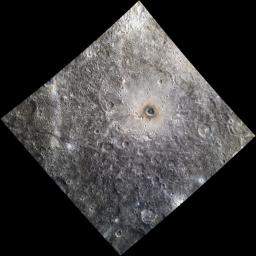
|
It Don’t Mean a Thing
- Click the image above for a larger view
- Full-Res JPEG (1422 x 1423) (243.5 kB)
- Full-Res TIFF (1422 x 1423) (6.1 MB)
Caption:
Ellington basin, named in 2012 for American jazz legend Duke Ellington (1899-1974), is a peak ring basin covered in secondary craters. The prominent crater Berkel lies inside of the basin. Berkel's ejecta and floor exhibit differences in reflectance and color, indicating a heterogeneous local stratigraphy. This image was created by merging a color image with a monochrome image, in order to emphasize both the topography and the color of the area.
The color portion of this image was acquired as part of MDIS's high-resolution 3-color imaging campaign. The 3-color campaign is a major mapping activity in MESSENGER's extended mission. It complements the 8-color base map (at an average resolution of 1 km/pixel) acquired during MESSENGER's primary mission by imaging Mercury's surface in a subset of the color filters at the highest resolution possible. The three narrow-band color filters are centered at wavelengths of 430 nm, 750 nm, and 1000 nm, and image resolutions generally range from 100 to 400 meters/pixel in the northern hemisphere.
The monochrome portion of this image is part of MDIS's high-resolution surface morphology base map. The surface morphology base map covers more than 90% of Mercury's surface with an average resolution of 250 meters/pixel (0.16 miles/pixel or 820 feet/pixel). Images acquired for the surface morphology base map typically have off-vertical Sun angles (i.e., high incidence angles) and visible shadows so as to reveal clearly the topographic form of geologic features.
Date acquired:
August 07, 2012
Image Mission Elapsed Time (MET):
252814064, 252814056, 252814060
Image ID:
2344652, 2344650, 2344651
Instrument:
Wide Angle Camera (WAC) of the Mercury Dual Imaging System (MDIS)
WAC filters:
9, 7, 6 (996, 748, 433 nanometers) in red, green, and blue
Center Latitude:
-14.85°
Center Longitude:
25.55° E
Resolution:
476 meters/pixel
Scale:
Ellington basin is 216 km (134 mi.) in diameter.
Incidence Angle:
19.3°
Emission Angle:
8.7°
Phase Angle:
28.0°
Background Info:
The MESSENGER spacecraft is the first ever to orbit the planet Mercury, and the spacecraft's seven scientific instruments and radio science investigation are unraveling the history and evolution of the Solar System's innermost planet. Visit the Why Mercury? section of this website to learn more about the key science questions that the MESSENGER mission is addressing. During the one-year primary mission, MDIS acquired 88,746 images and extensive other data sets. MESSENGER is now in a year-long extended mission, during which plans call for the acquisition of more than 80,000 additional images to support MESSENGER's science goals.
For information regarding the use of images, see the MESSENGER image use policy .
Cataloging Keywords:
| Name | Value | Additional Values |
|---|---|---|
| Target | Mercury | |
| System | ||
| Target Type | Planet | |
| Mission | MESSENGER | |
| Instrument Host | MESSENGER | |
| Host Type | Orbiter | |
| Instrument | Mercury Dual Imaging System (MDIS) | |
| Detector | Wide Angle Camera (WAC) | |
| Extra Keywords | Color, Crater, Map, Radio, Shadow | |
| Acquisition Date | ||
| Release Date | 2013-01-21 | |
| Date in Caption | 2012-08-07 | |
| Image Credit | NASA/Johns Hopkins University Applied Physics Laboratory/Carnegie Institution of Washington | |
| Source | photojournal.jpl.nasa.gov/catalog/PIA16756 | |
| Identifier | PIA16756 | |
